What Is a VBA User Defined Function?
A user defined function is a custom function made by users according to their needs. It is a collection of commands that is coded in VBA and returns the desired output.
Dissection of a VBA User Defined Function
By dissecting a user defined function in VBA, we can understand the structure of the function. The structure of the VBA user defined function is similar to the in-built functions. Let’s use the VLOOKUP function and dissect it.
=VLOOKUP (lookup_value, table_array, column_index_num, [range_lookup])We can divide the syntax of the function into 2 separate sections.
- The first section of the function syntax holds the name of the function. VLOOKUP in the function name.
- The second section consists of the function arguments. The arguments are written inside the parenthesis. There are 2 types of arguments in a function.
- Inside the parenthesis, we need to enter the mandatory arguments. You need to provide the value of these arguments for the function to work. lookup_value, table_array, and column_index_num are the mandatory arguments.
- There is another type of argument called optional argument. The value of these arguments is not compulsory to provide. Excel will assume a pre-specified value for the optional arguments if it is not provided. You can always specify the optional arguments to get a custom output. The optional arguments are written inside a third bracket. [range_lookup] is the optional argument.
Examples of How to Use VBA User Defined Function
Example 1 – User Defined Function with No Arguments
Let’s create a user defined function with no arguments.
In the following dataset, we have different Date Formats. We will create a user defined function in VBA to return the current date.
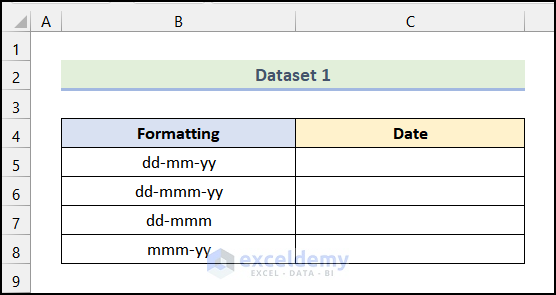
- Go to the Developer tab from Ribbon.
- Select the Visual Basic option.
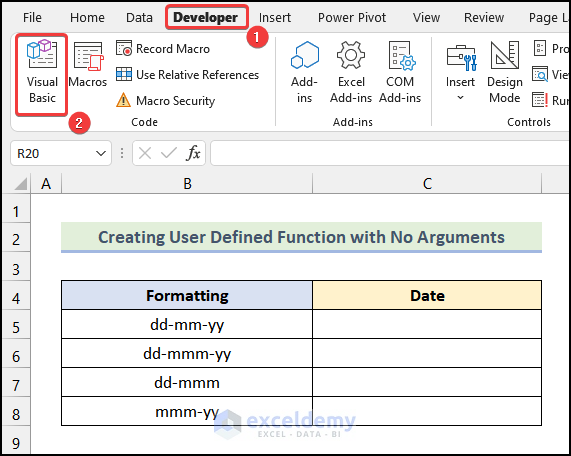
The Microsoft Visual Basic window will open.
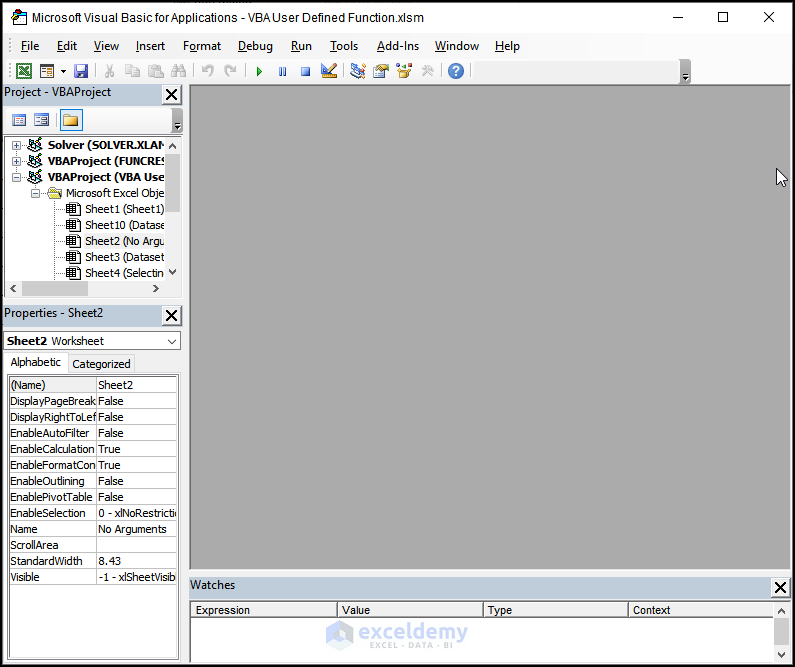
- Go to the Insert tab in the Microsoft Visual Basic window.
- Choose the Module option from the drop-down.
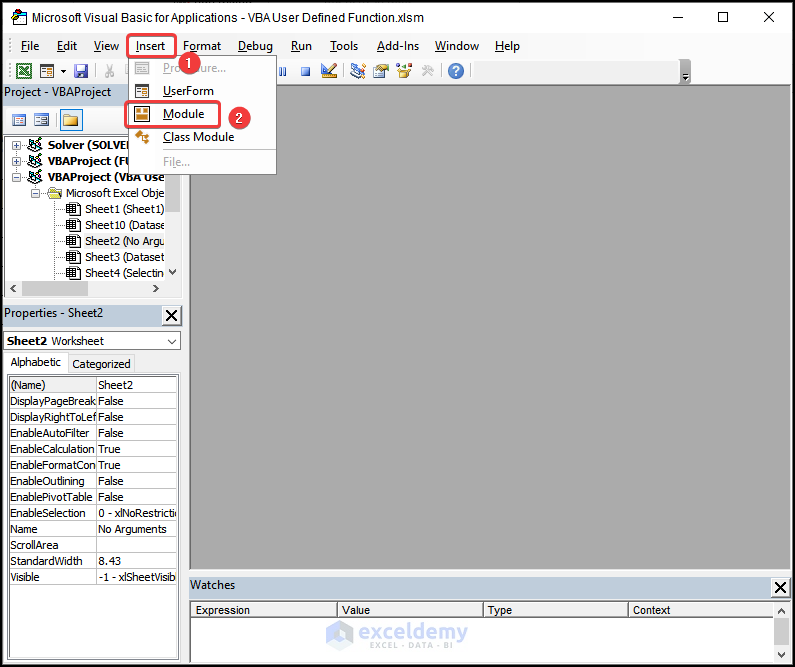
A blank Module will open.
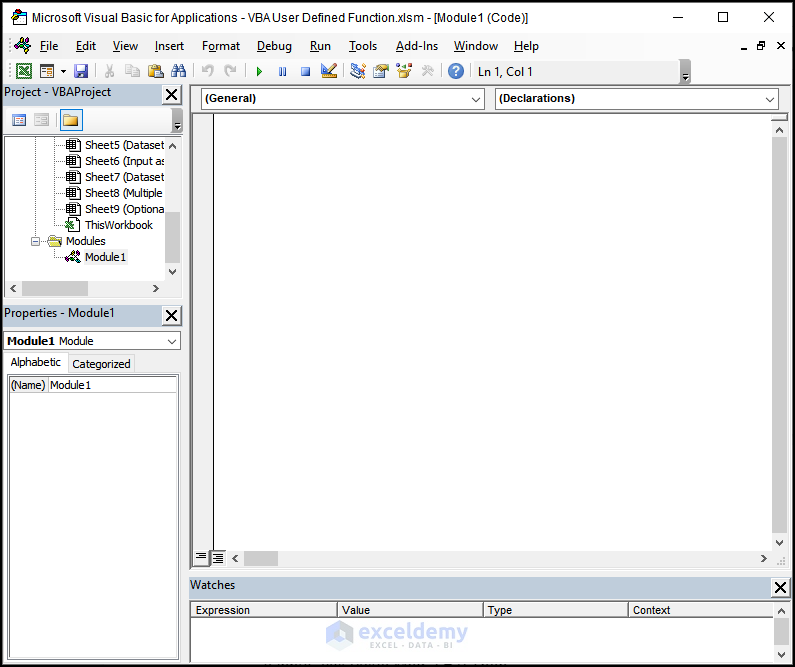
Step 2 – Writing VBA Code
- Enter the following code in the Module.
Function present_day() As Date
present_day = Date
End Function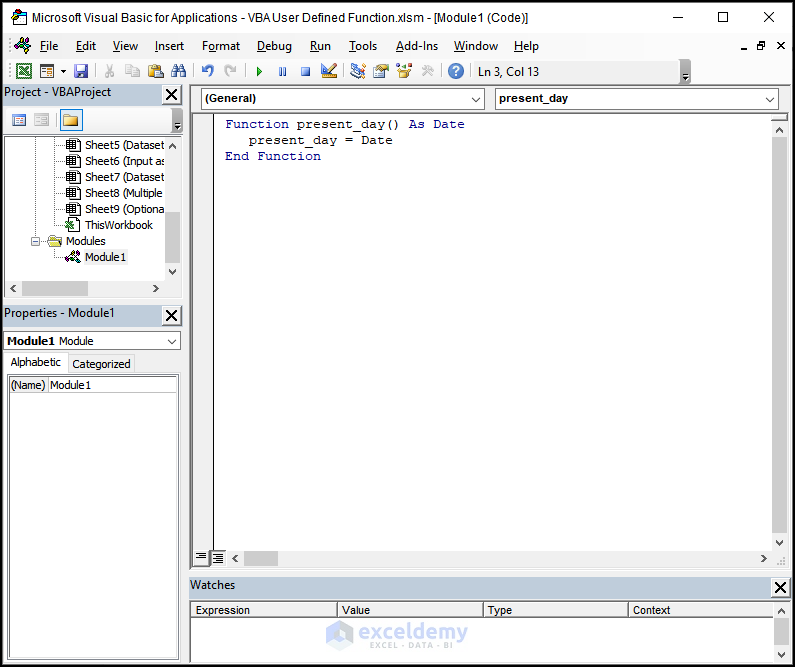
Code Breakdown
In the code, we:
- initialized the Function statement.
- specified the name of our function as present_day().
- declared the data type of the return value of the function As Date.
- used the Date function to assign current date in the present_day.
- ended the function.
- Click on the Save icon as marked in the following picture.
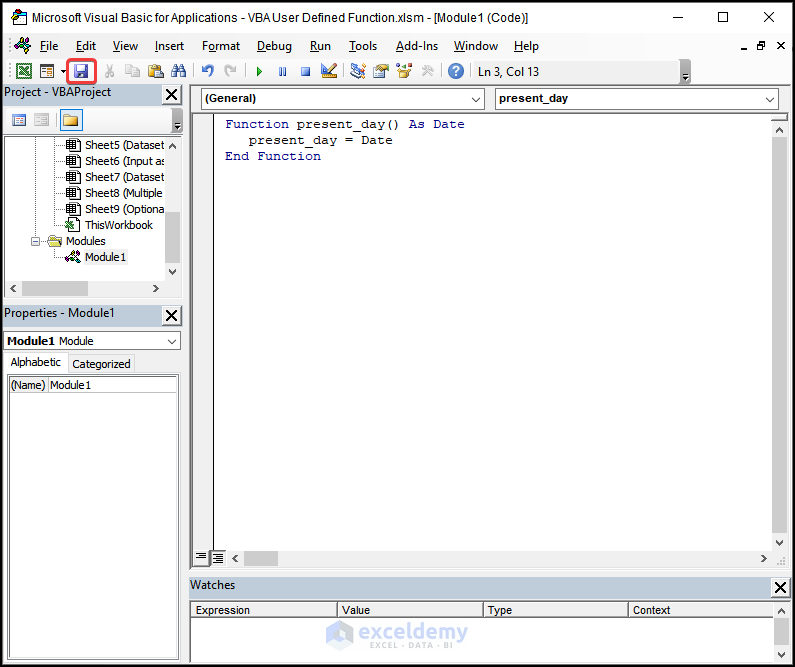
Step 3 – Using Function in Worksheet
- Press ALT + F11 to close the Microsoft Visual Basic window and open the worksheet.
- Enter the following formula in cell C5.
=present_day()- Press ENTER.
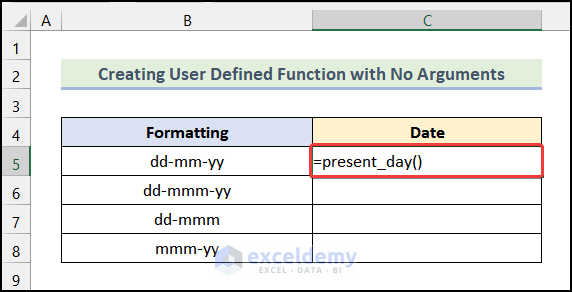
The current Date will be displayed.
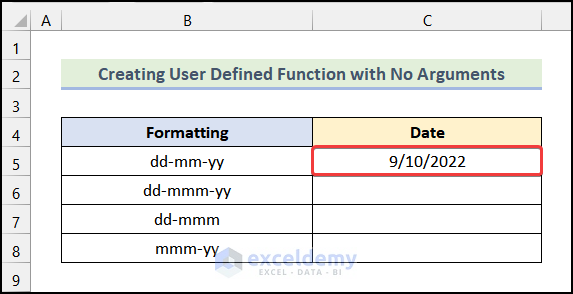
- Follow the same steps for the remaining cells.
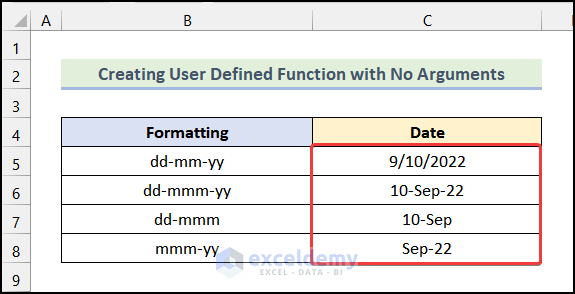
Example 2 – User Defined Function with Mandatory Arguments Only
Mandatory arguments can be provided either by selecting the cells or by selecting an array.
2.1 Providing Input by Selecting Cells in Mandatory Arguments
We select cells to provide input when we need to provide discrete values for the function’s arguments. In the following dataset, we have some data in kilometers units. We will create a user defined function in VBA that will convert the data in Kilometers to Miles.
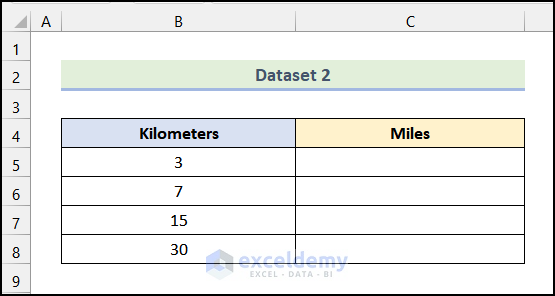
Steps:
- Follow the steps mentioned in Step 1 of Example 1 to create a blank Module.
- Enter the following code in the Module.
Function km_to_mile(kilometers As Double) As Double
km_to_mile = kilometers * 0.62137
End Function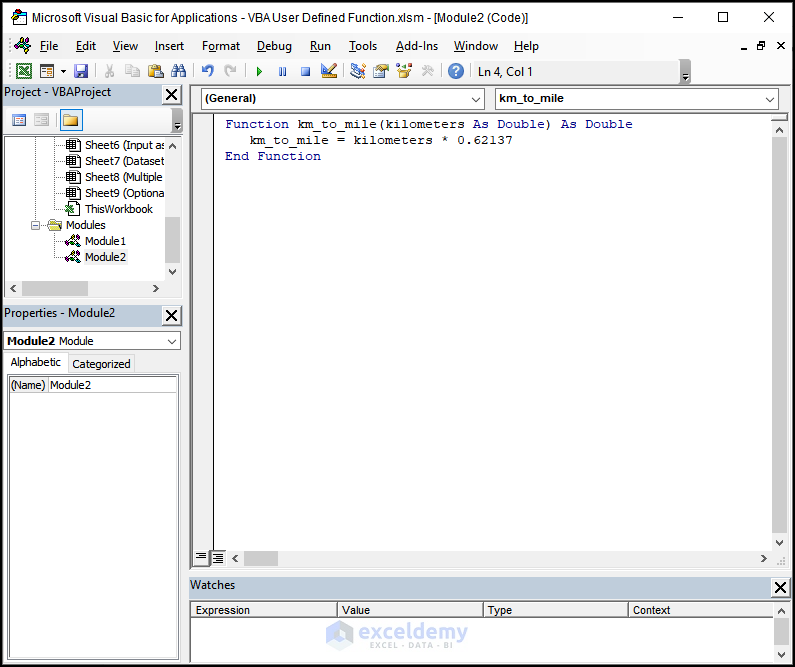
Code Breakdown
In the code, we:
- initialized the function by using the Function statement.
- named our function km_to_mile.
- introduced the argument of the function and its data type inside the parenthesis by kilometers As Double.
- specified the data type of the return value of the function As Double.
- multiplied the variable named kilometers by 62137 and assign it to km_to_mile.
- ended the function.
- Click on Save.
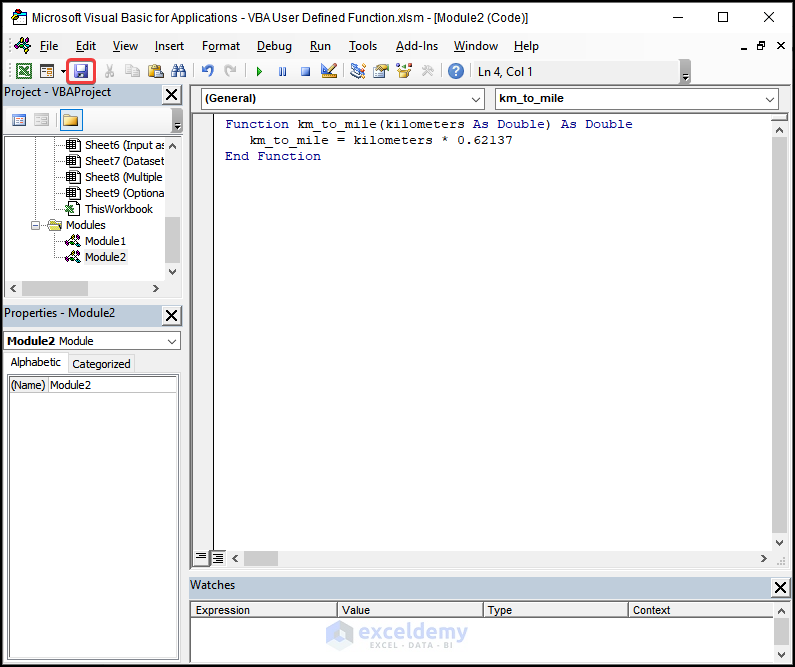
- Enter the following formula in cell C5.
=km_to_mile(B5)Cell B5 refers to the cell of the column Kilometers.
- Press ENTER.
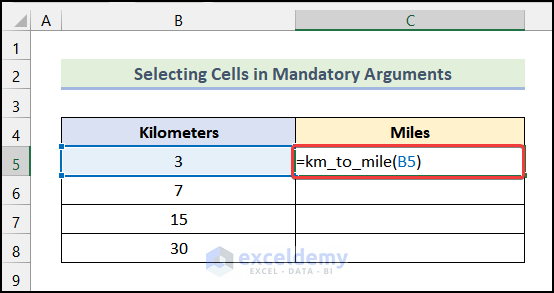
The kilometers data will be converted into the Miles unit.
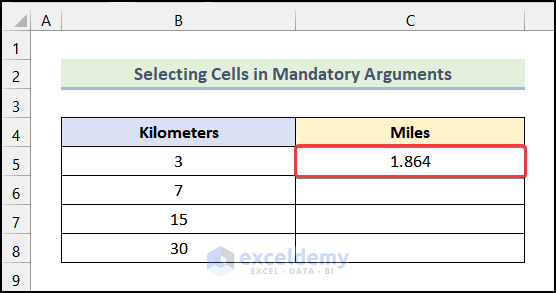
- Use the AutoFill feature for the remaining cells.
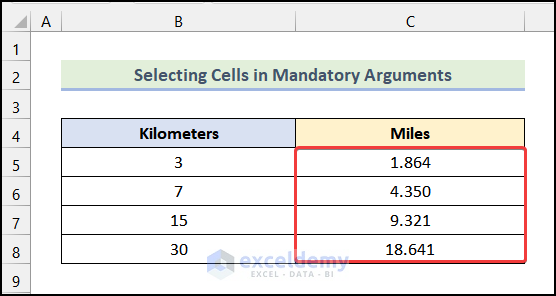
Read More: How to Use VBA Input Function in Excel
2.2 Giving Input as Array in Mandatory Arguments
Using following sample dataset, we’ll create a user defined function in VBA that will calculate the Sum of Even Numbers in a selected range.
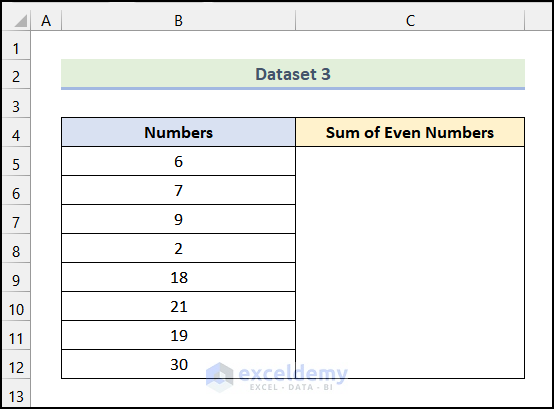
Steps:
- Create a blank Module.
- Enter the following code in the Module.
Function even_number_sum(input_range As Range)
Dim input_cell As Range
For Each input_cell In input_range
If IsNumeric(input_cell.Value) Then
If input_cell.Value Mod 2 = 0 Then
Sum = Sum + input_cell.Value
End If
End If
Next input_cell
even_number_sum = Sum
End Function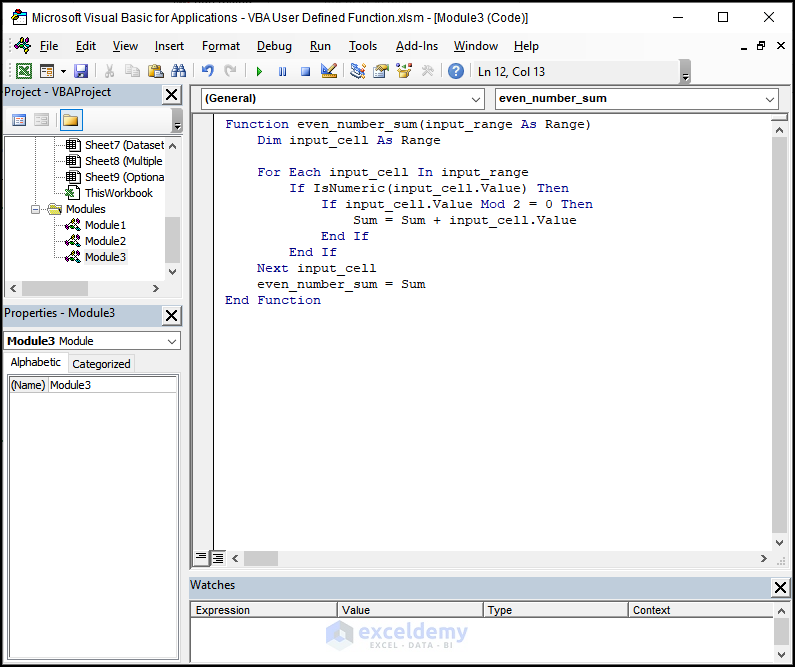
Code Breakdown
In the code, we
- started the Function statement.
- named our function even_number_sum.
- introduced the argument of the function and its data type by input_range As Range.
- declared a variable input_cell As Range.
- initialized a For Next loop and we will run this loop for each input_cell in the input_range.
- used an If statement to check whether the cell value is a number or not. If the cell value is a number, we will check whether the remainder of the number after dividing by 2 is 0 or not by introducing another If. If the remainder is 0 that means the number is an even number. So, we added the number by using Sum + input_cell.Value argument and assigned it to the Sum variable.
- closed the 2nd If statement.
- ended the 1st If statement.
- assigned the value of the Sum to even_number_sum.
- ended the function.
- Click on Save.
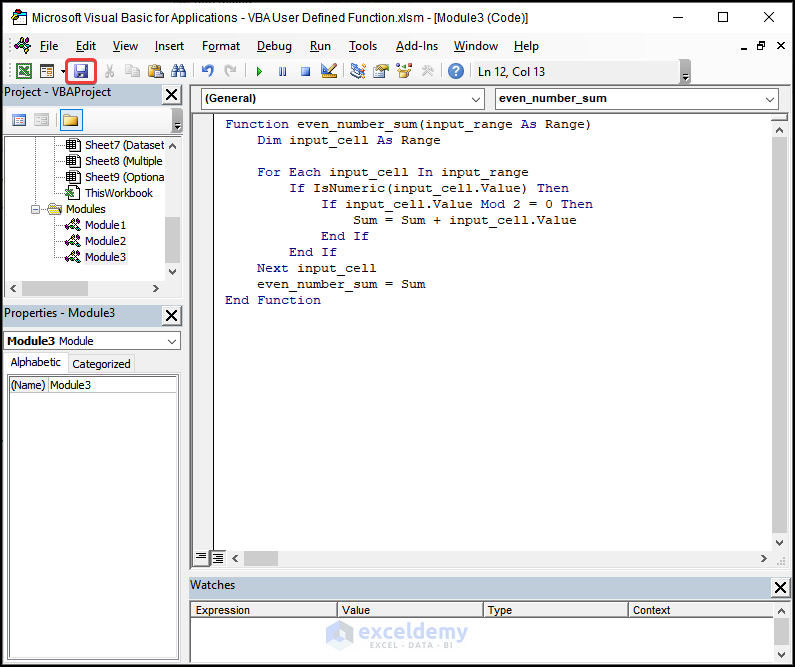
- Enter the following formula in the merged cell.
=even_number_sum(B5:B12)The range B5:B12 indicates the range of the Numbers.
- Press ENTER.
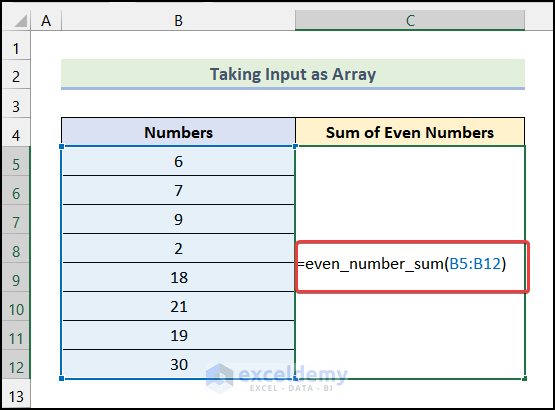
It will display the Sum of Even Numbers of the selected range.
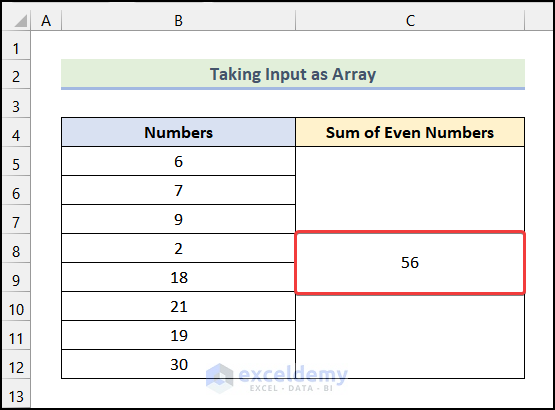
Example 3 – User Defined Function with Multiple Arguments
In the sample dataset below, we have 2 sets of Dates. We will create a user defined function that will compute the Day Difference between the 2 Dates.
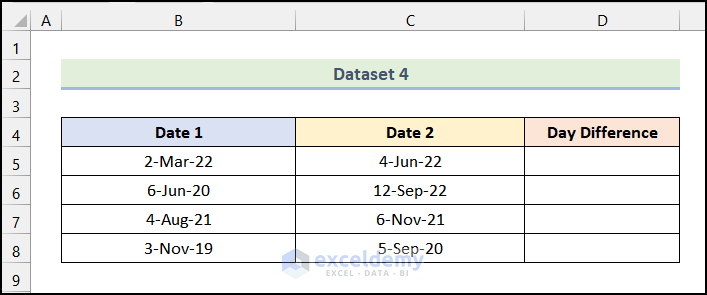
Steps:
- Create a blank Module.
- Enter the following code in the Module.
Function day_difference(date_1 As Date, date_2 As Date) As Integer
day_difference = date_2 - date_1
End Function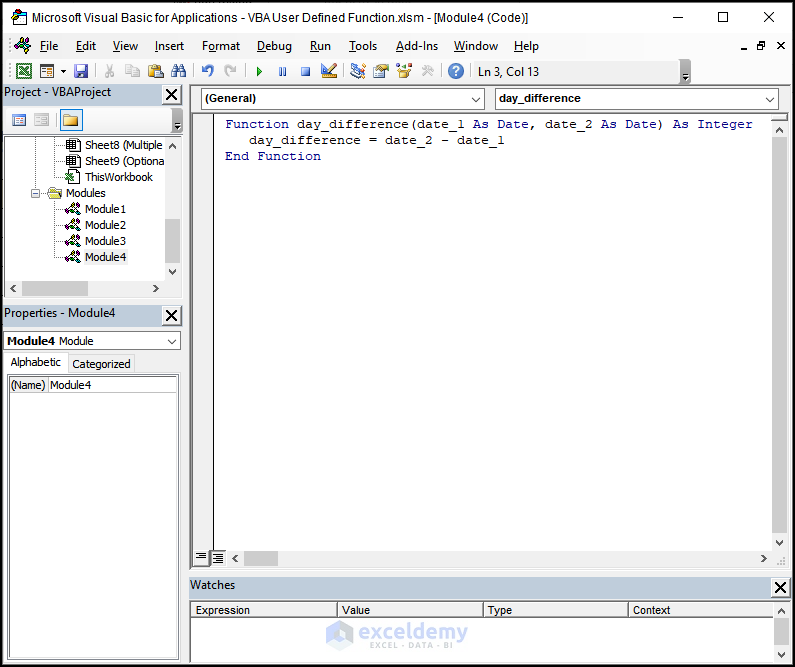
Code Breakdown
In the code, we
- initialized a function by using the Function statement.
- named the function day_difference.
- introduced 2 arguments of the functions and their data types as date_1 As Date, and date_2 As Date.
- declared the data type of the return value of the function As Integer.
- subtracted date_1 from date_2 and assigned the value in day_difference.
- ended the function.
- Click on Save.
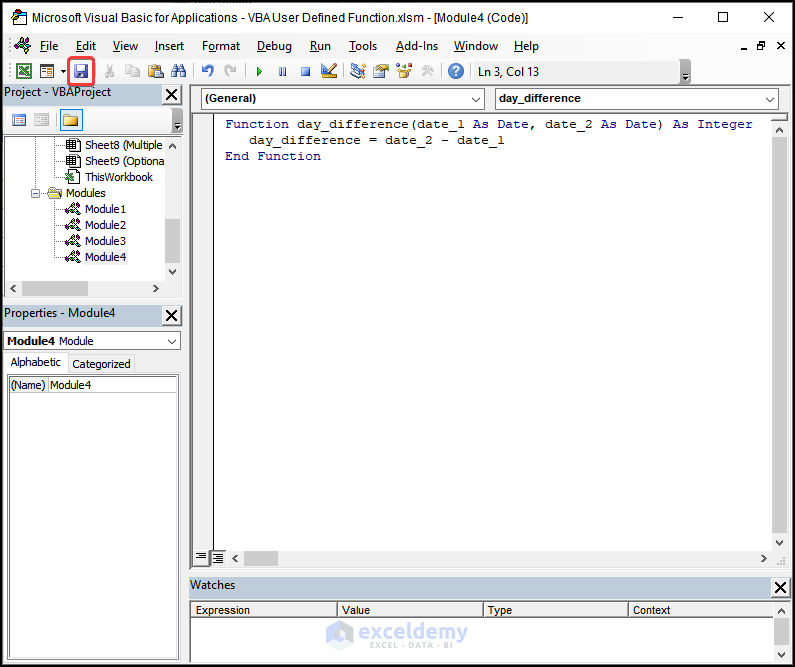
- Enter the following formula in cell D5.
=day_difference(B5,C5)Cell B5 refers to the 1st Date and cell C5 indicates the 2nd Date.
- Press ENTER.
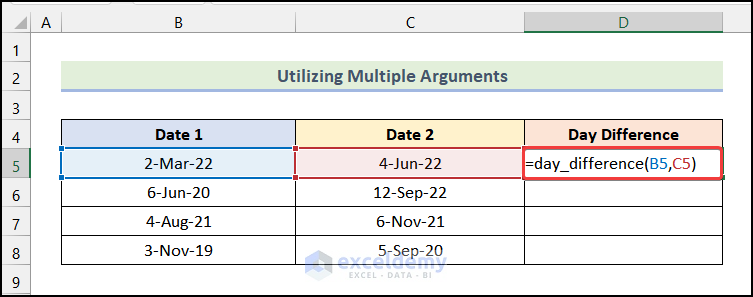
You will get the Day Difference between the 2 Dates.
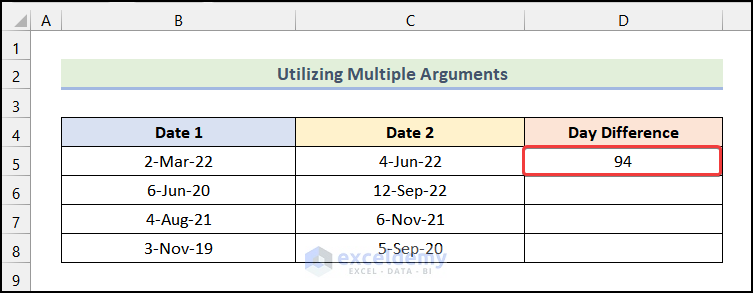
- Use the AutoFill option to get the remaining output.
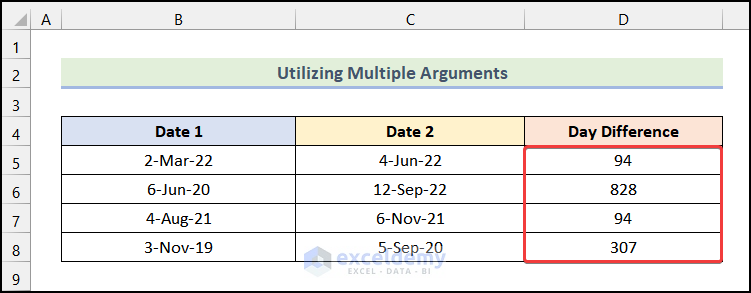
Example 4 – User Defined Function with Optional Arguments
Using the sample dataset below, we will create a user defined function to convert the Texts into our Desired Format.
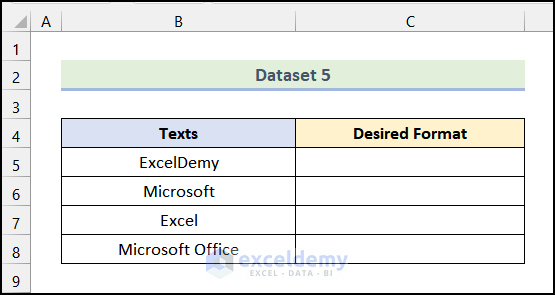
Steps:
- Create a blank Module.
- Enter the code given below in the Module.
Function fetch_text(cell_reference As Range, Optional text_case = False) As String
Dim length_of_string As Integer
Dim output As String
length_of_string = Len(cell_reference)
For i = 1 To length_of_string
If Not (IsNumeric(Mid(cell_reference, i, 1))) Then output = output & Mid(cell_reference, i, 1)
Next i
If text_case = True Then output = UCase(output)
fetch_text = output
End Function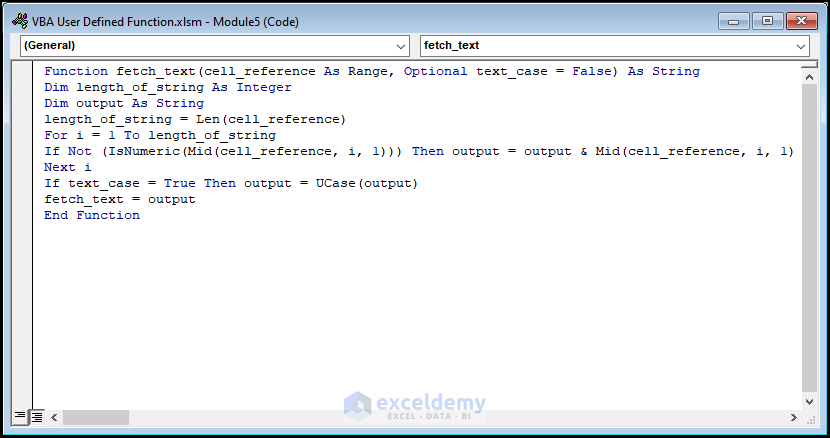
Code Breakdown
In the code, we
- initialized a function by using the Function statement.
- named the function fetch_text.
- specified the mandatory argument of the function and its data type by cell_reference As Range.
- declared our optional argument as Optional text_case. Assign the value of the optional argument, if it’s not specified by the user as False.
- declared the data type of the return value of the function As String.
- introduced 2 variables named length_of_string As Integer and output As String.
- used the Len function to calculate the length of the string and assigned the value to the variable named length_of_string.
- initialized a For Next loop with the initial value of i as 1 and a maximum value up to the length_of_string.
- used the If statement and the IsNumeric function.
- used the Mid function.
- used another If statement to check the optional argument of the function. If it is True, we used the Ucase function to return the text in upper case format and we assigned the value in output.
- assigned the value of output in fetch_text.
- ended the function.
- Click on Save.
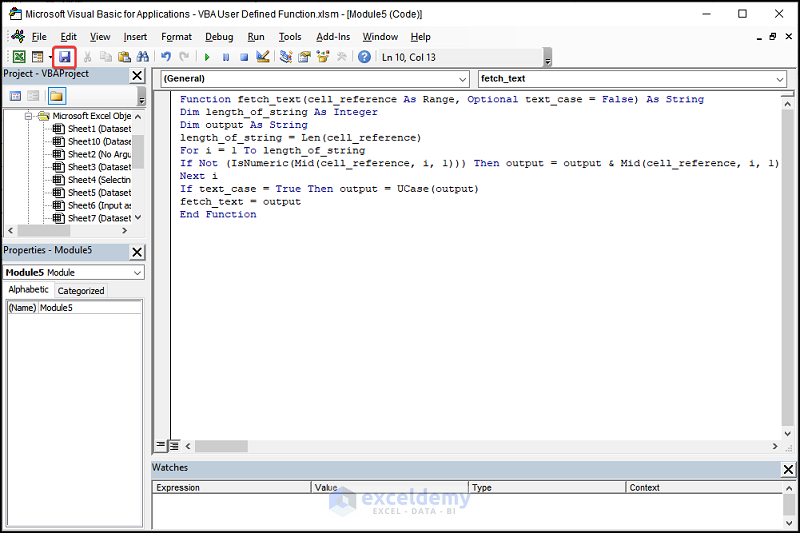
- Enter the formula given below in cell C5.
=fetch_text(B5,TRUE)Cell B5 represents the cell of the column Texts and the optional argument TRUE means that we want the upper case letters.
- Press ENTER.
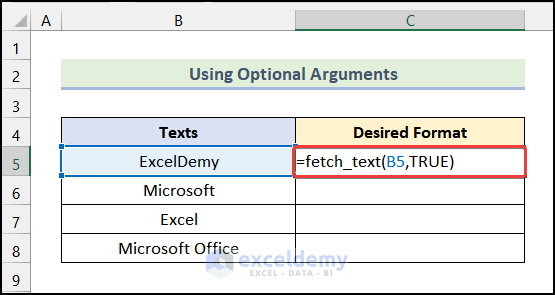
You will get the text in the Desired Format.
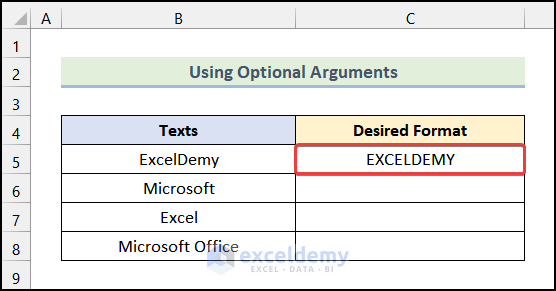
- Enter the following formula in cell C6.
=fetch_text(B6,FALSE)We have used FALSE as our optional argument. For this reason, the text will stay as it is.
- Press ENTER.
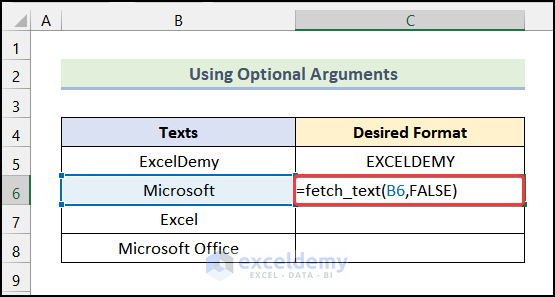
The text output will be same as the original.
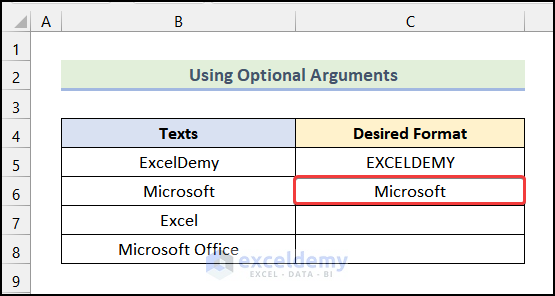
- Insert the following formula in cell C7.
=fetch_text(B7)We haven’t used any optional arguments here. Excel will assume the optional argument as FALSE.
- Press ENTER.
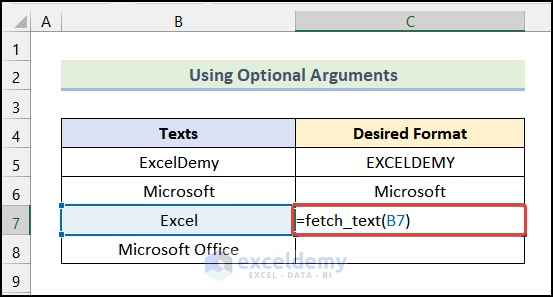
You will get the following output.
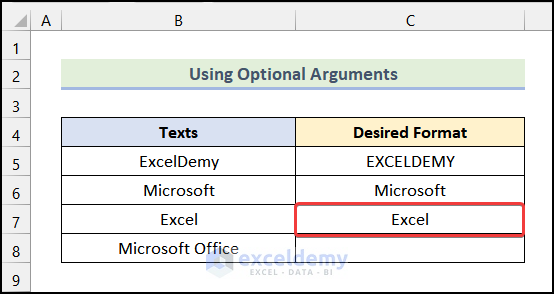
- Follow the same steps to get the output for the remaining cell.
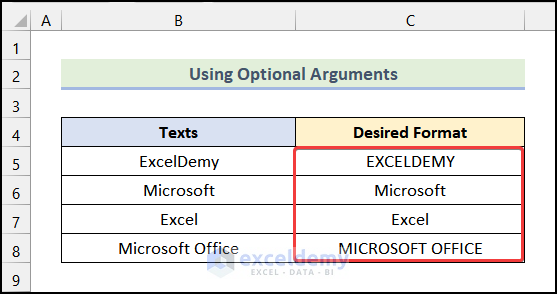
Read More: How to Make VBA Function with Arguments in Excel
Benefits of Applying VBA User Defined Functions
- Creating custom functions to meet your needs is one of the main benefits of using user defined functions.
- Another benefit is the ability to substitute complex formulas.
- If you want to add dynamic features into your code, user-defined functions are a good alternative to subroutines. VBA code itself is not inherently dynamic, and needs to be run again every time you change input. However, with user-defined functions, the output will be updated automatically when you change the input.
Shortcomings of VBA User Defined Function
- You can’t use a user defined function to alter the value of another cell.
- User defined functions can’t add, format, or remove cells from your worksheet.
- User defined functions can’t change Excel’s environment settings.
- User defined functions are considerably slower than built-in functions, especially with large datasets.
Download Practice Workbook
Related Articles
- Excel VBA Function to Return Multiple Values
- How to Execute VBA Function Procedure in Excel
- How to Return a Value in VBA Function
- VBA Sub Vs Function in Excel
- How to Create and Use ColorFunction in Excel
- Difference Between Subroutine and Function in Excel VBA
- How to Create Custom Function in Excel VBA


